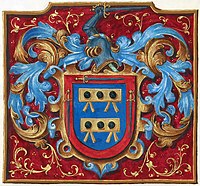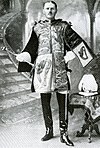Portal:Heraldry
Welcome to the Heraldry and Vexillology Portal!


Vexillology (from the Latin vexillum, a flag or banner) is the scholarly study of flags, including the creation and development of a body of knowledge about flags of all types, their forms and functions, and of scientific theories and principles based on that knowledge. Flags were originally used to assist military coordination on the battlefield, and have evolved into a general tool for signalling and identification, particularly identification of countries.
Heraldry encompasses all of the duties of a herald, including the science and art of designing, displaying, describing and recording coats of arms and badges, as well as the formal ceremonies and laws that regulate the use and inheritance of arms. The origins of heraldry lie in the medieval need to distinguish participants in battles or jousts, whose faces were hidden by steel helmets.
Selected coat of arms

A Scottish crest badge, more commonly called a clan crest, is a heraldic badge worn to show one's allegiance to a specific Scottish clan. Crest badges may be worn by any member of a clan. Even though it is the most common name, the term clan crest is a misnomer. There is no such thing as a clan crest. Modern crest badges usually consist of the clan chief's personal crest surrounded by a strap and buckle and the chief's motto or slogan. Although "clan crests" are commonly bought and sold, the heraldic crest and motto belong to the chief alone and never the clan member. Crest badges, much like clan tartans, do not have a long history, and owe much to Victorian era romanticism, having only been worn on the bonnet since the 19th century. The original badges used by clans are said to have been specific plants worn in bonnets or hung from a pole or spear. (more...)
Selected flag

The Fairy Flag (Scottish Gaelic: Am Bratach Sìth) is an heirloom of the chiefs of Clan MacLeod. It is held in Dunvegan Castle along with other notable heirlooms, such as the Dunvegan Cup and Sir Rory Mor's Horn. The flag is made of silk, is yellow or brown in colour, and measures about 18 inches (46 cm) square. Now ripped and tattered, it is extremely fragile. The flag is covered in small red "elf dots". In the early part of the 19th century, the flag was also marked with small crosses, but these have since disappeared. The flag may have been an important relic, perhaps from the Crusades, or it may have even been a raven banner.
There are numerous stories associated with the flag, most of which deal with its magical properties and mysterious origins. Clan tradition, preserved in the early 19th century, tells how the Fairy Flag was entrusted to a family of hereditary standard bearers. Tradition states that the flag was unfurled at several clan battles in the 15th and 16th centuries; the flag's magical powers are said to have won at least one of them. In the mid 20th century, the Fairy Flag was said to have said to have extinguished a fire at Dunvegan Castle, and to have given luck to servicemen flying bombing missions in the Second World War. (more...)
Selected article

The Lion and Sun or Shir-o-khorshid (Persian: شیر و خورشید) is one of the better-known emblems of Iran, and between 1423 and 1979 was an element in Iran's national flag. The motif, which combines "ancient Iranian, Arab, Turkish, and Mongol traditions", became a popular symbol in Iran in the 12th century. The lion and sun symbol is based largely on astronomical and astrological configurations: the ancient sign of the sun in the house of Leo, which itself is traced backed to Babylonian astrology and Near Eastern traditions.
During the Safavid era, the lion and sun stood for the two pillars of society, the state and the Islamic religion. It became a national emblem during the Qajar era. In the 19th century, European visitors at the Qajar court attributed the lion and sun to remote antiquity; since then, it has acquired a nationalistic interpretation. During the reign of Fat'h Ali Shah and his successors, a crown was also placed on the top of the symbol to represent the monarchy. Beginning in the reign of Fat'h Ali Shah Qajar, the Islamic aspect of the monarchy was de-emphasized. The emblem remained the official symbol of Iran until the 1979 revolution, when the "Lion and Sun" symbol was removed from public spaces and government organizations, and replaced by the present-day Emblem of Iran. (more...)
Selected picture
Illustration from a manuscript grant of arms by Philip II of Spain to Alonso de Mesa and Hernando de Mesa, signed 25 November 1566. Digitally restored.
Did you know...
- ...that the British First World War general Sir William Peyton (pictured) served as Delhi Herald Extraordinary at the Delhi Durbar of 1911?
- ...that Rodney Dennys left his career in the British intelligence service to become an officer of arms?
- ...that the Dering Roll begins with the coats of arms of two illegitimate sons of King John of England?
- ...that the Raven banner, a standard used by various Viking leaders including Sigurd the Stout and Harald III of Norway, was a totem believed to have the power to grant victory to its holder?
- ...that Paul Bunker died in a Japanese POW camp in 1943 but kept hidden a remnant of the U.S. flag from the Battle of Corregidor now displayed at the West Point Museum?
Related portals
|
|
|
Heraldry Web resources
Authorities
- Belgium - The Council of Nobility, Flemish Heraldic Council and Council of Heraldry and Vexillology of the French Community
- Canada - Canadian Heraldic Authority and see also Public Register of Arms, Flags and Badges
- England, Wales, and Northern Ireland - The College of Arms
- Ireland - The Office of the Chief Herald of Ireland
- Netherlands - High Council of Nobility
- Portugal - Instituto da Nobreza Portuguesa
- Scotland - The Court of the Lord Lyon
- South Africa - South African Bureau of Heraldry
- Sweden - National Board of Heraldry, The National Archive
- United States Army - The United States Army Institute of Heraldry
Societies
- Greek Heraldry Society
- The Academy of Heraldic Science Czech republic
- The American College of Heraldry
- The American Heraldry Society
- The Augustan Society
- The Australian Heraldry Society Inc.
- Bulgarian Heraldry and Vexillology Society
- The Center for Research of Orthodox Monarchism
- Cambridge University Heraldic and Genealogical Society
- Chiltern Heraldry Group
- The College of Dracology
- Croatian Heraldic and Vexillologic Association
- The Finnish Heraldic Society
- Fryske Rie foar Heraldyk
- Hellenic Armigers Society
- Guild of Heraldic Artists
- Genealogical Society of Ireland
- Heraldry Research Institute (Japan)
- The Heraldry Society
- The Heraldry Society of Africa
- The Heraldry Society of New Zealand Inc.
- The Heraldry Society of Scotland
- The Heraldry Society of Southern Africa
- The Institute of Heraldic and Genealogical Studies
- The International Association of Amateur Heralds
- Italian Center of Vexillological Studies
- Lancashire Heraldry Group
- Macedonian Heraldry Society
- New England Historic Genealogical Society Committee on Heraldry
- Norwegian Heraldry Society
- Oxford University Heraldry Society
- Polish Heraldry Society
- Polish Nobility Confederation
- Real Academia Matritense de Heráldica y Genealogía - Royal Academy of Heraldry and Genealogy of Madrid
- Romanian Institute for Genealogy and Heraldry
- The Royal Heraldry Society of Canada
- The Russian College of HeraldryThe Russian College of Heraldry
- Serbian Heraldic Society
- Societas Heraldica Scandinavica
- Societas Heraldica Slovenica
- Swedish Heraldic Society
- Ukrainian Heraldry Society
- Royal Association Genealogical and Heraldic Office of Belgium
Vexillology
Software
- Coat of Arms Visual Designer web-based program
- Puncher Heraldry Program
- Blazonry Server - pyBlazon
- DrawShield - creates SVG shield or arms image from blazon
- CoaMaker - web-based tool
- Blazon95 and BLAZONS! 2000, older Windows applications
Texts
- Heraldry, historical and popular : with seven hundred illustrations (1863)
- A Complete Guide to Heraldry (1909)
Other
Wikimedia
The following Wikimedia Foundation sister projects provide more on this subject:
-
Commons
Free media repository -
Wikibooks
Free textbooks and manuals -
Wikidata
Free knowledge base -
Wikinews
Free-content news -
Wikiquote
Collection of quotations -
Wikisource
Free-content library -
Wikispecies
Directory of species -
Wikiversity
Free learning tools -
Wikivoyage
Free travel guide -
Wiktionary
Dictionary and thesaurus













